How to download embedded videos from those websites you love? Embedded videos may be hosted by different services, such as YouTube videos, Vimeo, Wistia Video, JW Player, or in forms of m3u8 playlists, DASH, blob, HSL streaming. Sometimes, you can't find the "Save video as" option.
This post covers easy ways to save embedded videos to your local drive, and you can switch among methods for different websites. For tech-savvy users interested in digging out more, we also include tips using dev tools.
For anyone needing the easiest solution with batch downloading, auto analyzing and video quality options, go with method 1 below.
Method 1 . Download Embedded Videos Easily with VideoProc
Downloading embedded videos usually involves:
-Find the true video link on a page.
-Save the video or use a downloader.
For beginners, it's hard to dig out the true video link hidden in complex code. That's where VideoProc Converter AI comes to help. It can analyze the website URL of the embedded videos, and find out the corresponding link that truly contains the video file. Let's see how it works:
Preparation: Download and install VideoProc Converter AI on your Windows or Mac computers.
Step 1. Launch the program, and click the Downloader icon from the main screen.
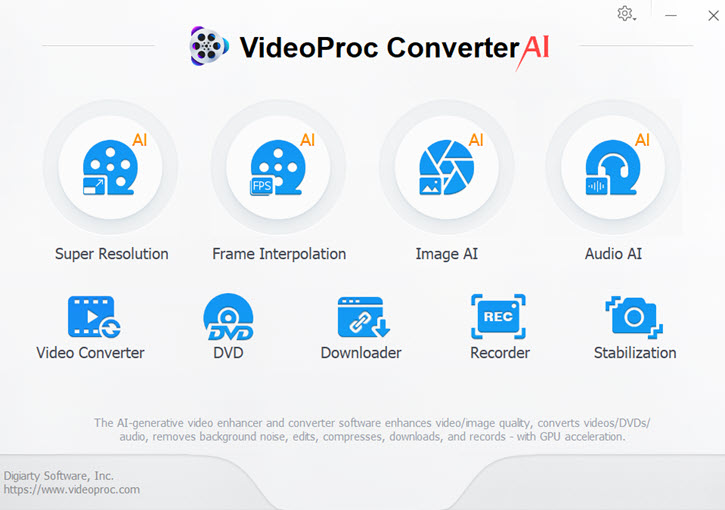
Step 2. Paste the link and hit Analyze.
You can try with the direct video link or the URL of the webpage hosting that video.
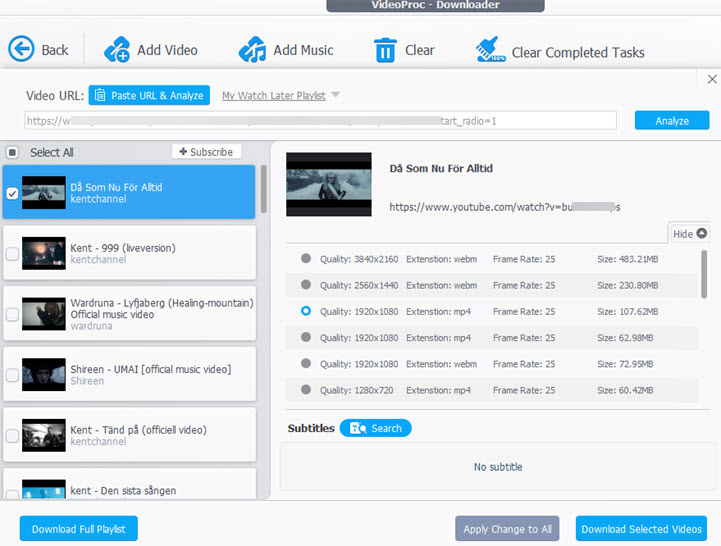
Note
- Sometimes the video link matches the webpage link, while in other instances, they may differ. Feel free to use whichever link that works.
- For embedded videos from YouTube, you can copy the video link or the playlist link. If the playlist link won't work, you can remove the "&list=…" part (such as "&list=xSHlkitlswq"), keeping only the URL containing video id.
- If you cannot find the link, check if there is any share button near the player, which usually contains the video link. Or right-click on the player for the "copy video link" option.
Step 3. When the analysis is done, choose the desired video format and resolution to download.
You can repeat the process to add multiple videos into the queue. If something went wrong, you can refer to the detailed troubleshoot steps here, covering all kinds of scenarios.
Step 4. Hit the Download button to save all the videos to your local disk.
Disclaimer: Make sure you have permission from the content owner before downloading, or grab videos that are in the public domain.
Bonus Tip:

VideoProc Converter AI also helps you to record live-streaming videos, at original high quality, and preserve sounds in the video. With a built-in editor and converter, this App allows you to cut and edit videos with ease. You can trim unwanted parts off, enhance video quality, remove background noise from the video, etc.
Click the buttons below to install VideoProc Converter AI.
Method 2. Download Embedded Videos with Chrome Extensions
Using online extensions for Chrome and Firefox, you can rip embedded videos from websites easily. One of the popular free extension is Video DownloadHelper, it is available in Chrome Webstore and Firebox add-on store. Do not search it directly in the extension store, because there are tons of extensions sharing similar names. Make sure the one you install has an icon of red, yellow, and blue balls.

It can parse the address link of the website videos and save them to your local disk. The success rate is relatively high, and it supports videos embedded and streaming under different protocols, including HLS (HTTP Live streaming) and DASH videos.
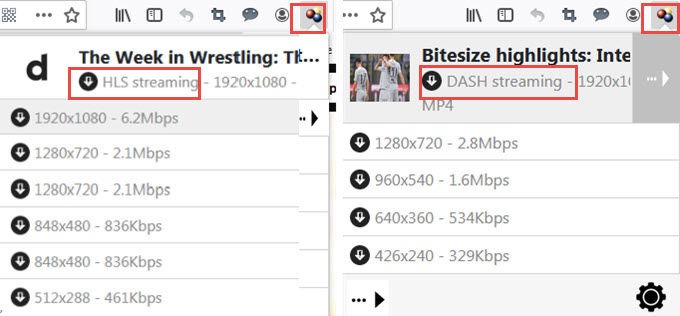
How to download embedded video with this add-on:
Step 1. Install the extension to your browser. If it doesn't appear in the extension bar, you can manually enable it and pin this extension.
- For Firefox users, go to Settings > Add-ons. You can also use the shortcut key Ctrl+Shift+A.
- For Chrome users, go to Settings > More tools > Extensions.
Step 2. Refresh the page that contains the video you want.
If the Video DownloadHelper is greyed out, or it says "No video to process in the current tab", make sure you have hit the Play button of the video. Then you shall see the icon turns colorful, and can detect the video that's playing.
Step 3. Click on the extension, and select a format and resolution preset you like. If you have high-speed network, you can download 1080p or even 4k videos.
This extension also allows you to download image galleries and intuitively name the video files. It can block ads and annoying pop-ups.
Method 3 . Download Embedded Videos with Online Tools
You can also extract embedded videos from websites using online downloaders. These online tools work more or less the same: copy and paste the webpage addresses, wait for the tool to analyze, select output settings, and start downloading. Some online tools will automatically open up new tabs in every process, or require you to watch ads and then go ahead downloading. There are still other tools that go without ads, but put limitations on video length.
There are other concerns. Some online tools only work for a specific hosting service. For instance, there are dedicated Dailymotion downloaders that may not work for Facebook or Twitch videos.
Therefore, when it comes to online tools, it's more about which tools to use than about how-tos.
Once you encounter an embedded video on a page, the first thing is to determine which server is hosting that video. For instance, YouTube and Vimeo videos have different player interface designs that you can quickly recognize it.
- For embedded YouTube videos, we tested and verified these tools nice and ads free: You can read detailed reviews and tutorials here.
- For Twitch videos, tools offered by getfvid.com and untwitch.com are handy and efficient.
- For videos embedded on Reddit, redditsave.com works nicely with sound and audio preserved too.
For Tech-Savvy Users: Use Dev Tools, VLC, or YT-DLP
1) Download an Embedded Video with Chrome Developer Tool
More often than not, you cannot directly see the true link address of the video. Gone are the times when you can right-click on the video and select copy address. With the help of Developer Tool, you might be able to find out the video link. Let's jump into the steps:
Step 1. On the website page with the video you want to download, right-click and select the Inspect option (also known as the Developer Tool). If websites that block right-click, there are three ways to bring up the Inspect tool:
- Press F12 on the keyboard.
- Press Ctrl+Shift+I simultaneously (for Mac, replaces Ctrl with Cmd ⌘ key).
- Click the settings (a three-dot icon in the upper right corner) in Chrome > More Tools > Developer Tools.
Tips:
The inspection tool is docked to right by default. If it somehow changes position, and you feel the layout unfamiliar, you can click the settings icon and choose the dockside again.


Step 2. Click the Network tab. It sits between the Sources and Performance tabs.
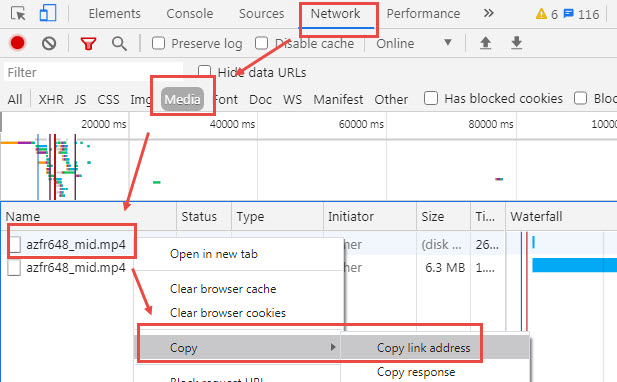
Step 3. Under the Network tab, click the Media tab, which is next to JS, CSS, and Img.
Step 4. Now start playing the video on that page, and you will see a media file with an extension of MP4 or other video formats.
Note:
1. If there are too many items displayed in the Media, you can refresh the browser, pause and restart playing the video.
2. If you don't see anything under the media, you need to refresh the page and make sure the video is playing. Because this feature in the developer tool is trying to record what's going on, and if the video is stopped/paused, you won't see it show up as network activity.
To recap, here is what to do when media isn't showing up:
- Press the Refresh icon (F5) to refresh the page; you can even press Ctrl+F5 to force refresh the page (Cmd+F5 on Mac).
- Make sure the video is playing.
- Hit Ctrl+R to record the reload of the network activity.
Step 5. Right-click on that media > Copy > Copy link address. It will be an address that ends with the file extension.
Tips: You can also download embedded flash video files with this method. Simply find the address that ends with .swf instead of .mp4. But you have to be quick because the Flash videos are being phased out in popular browsers. Adobe will stop supporting Flash on Dec. 31, 2020.
Step 6. Open up a new tab in your browser, paste that address, and hit Enter.
The browser's default player will play the video, and also gives you the option to save it.
Step 7. Right-click on the video, hover to the option Save video as.
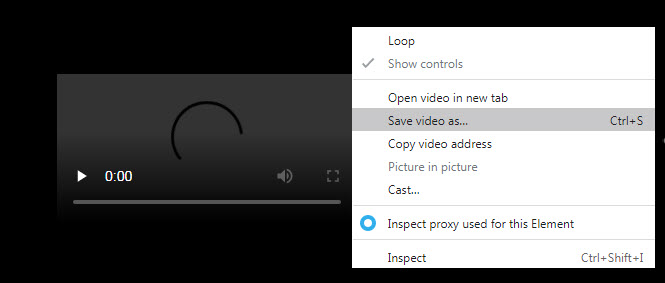
Step 8. Select an output folder on your local drive. You can also rename the file during this process. Click Save and wait until the downloading finishes.

It relies on the downloading utility of your browser, and can be unstable sometimes, especially for large size videos. It's a nightmare when the downloading is stuck at 99%, and resume downloading starts all over again instead of finishing that last one percent.
2) Save Embedded Videos to Local Disk with VLC
VLC supports playing online videos directly inside the VLC player, or convert the URL into an MP4 or other video formats. However, it does not support parsing the webpage link to find out the URL of the video file. You still need to manually find out the link before pasting it into VLC.
You may wonder, why not use the developer tools introduced in the previous part? The fact is, not all the link addresses can be directly downloaded using the browser's default downloader. For instance, besides MP4, WebM, or FLV files, there are media files streamed via m3u8 playlists. With VLC, you can convert m3u8 to mp4 easily and safely.
Taking twitter embedded videos as an example:
Step 1. In the develop tools window (F12), when you navigate to Network > Media, and refresh the page, you cannot find something that ends with MP4. Let's try searching m3u or m3u8 instead.
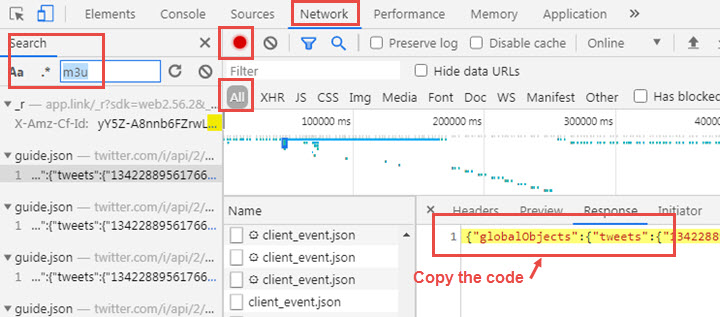
Step 2. You shall see some results. Copy out the code and paste it in a text editor, such as Microsoft Office Word.
Step 3. Find the address that ends with .m3u8 in that large chunk of code.
It is something that looks like this:
https:\/\/video.twimg.com\/amplify_video\/blahblah\/pl\/blahblah.m3u8
Step 4. Replace \/ with // and you will get something like this:
https://video.twimg.com/amplify_video/blahblah/pl/blahblah.m3u8
With the link at hand, now let's see how it works in VLC:
Step 5. Download and install VLC from its official site.
Step 6. From the menu, click Media > Open Network stream (For Mac version: File > Open Network). The hotkey is Ctrl/Cmd+N.
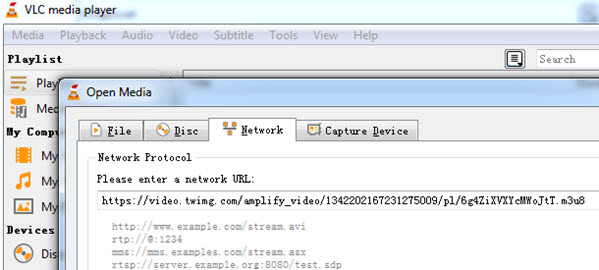
Step 7. Copy and paste the video address into the box.
Step 8. Switch the option from Play into Convert.
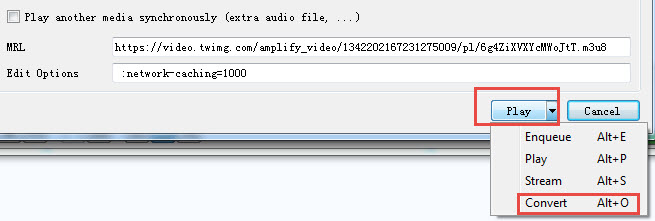
For Mac users, the option is slightly different. Check the Stream output box, and click Settings.

Step 9. In the newly opened window, select the output format and destination folder. Name your file while selecting the local folder.
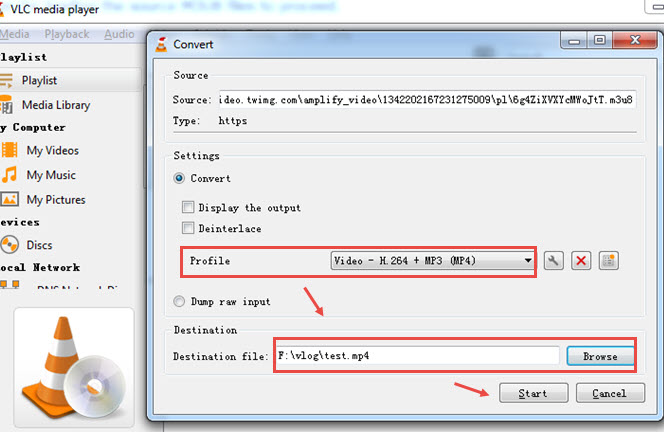
Step 10. Click Start and wait until VLC finishes its job. You shall see the blue progress bar reaches the end, and go open the destination folder to check the video.
3) Download Embedded Videos with YT-DLP
When the embedded video uses streaming protocols like HLS (identified by .m3u8 files found via Method 3 using the Dev tool), you can use yt-dlp if you are comfortable with the command line tool.
Update: Due to recent changes, downloading videos from certain platform now requires an additional step. yt-dlp needs a JavaScript runtime called Deno to function correctly.
The easiest way is to download the Deno executable for your operating system.
- Find the latest releases on the official Deno GitHub page.
- Place it in the same folder as your yt-dlp.exe file.
- In folder where you saved yt-dlp.exe, type cmd in the address bar and press Enter.
- In the command prompt window, type the following command and press Enter: yt-dlp -U
For people using using pip, type this: pip install -U "yt-dlp[default]" to ensure all necessary components are installed.
Now, your yt-dlp installation is fully equipped to handle the new requirements for certain video platforms. You can follow the general steps below to save embedded videos.
Step 1. Obtain the .m3u8 URL.
Step 2. Install yt-dlp, a versatile command-line downloader.
Step 3. Open your system's command prompt or terminal.
Step 4. Execute the download command using the copied .m3u8 URL:
yt-dlp "YOUR_M3U8_URL_HERE"
Note:
- Having the correct .m3u8 URL is essential for this method. These tools are necessary for downloading HLS streams which are common for embedded videos.
- m3u8downloader is suggested as an alternative if yt-dlp fails with a specific m3u8 link.
It is a Python-based command-line tool (installable via pip: pip install --user m3u8downloader).
For m3u8downloader, execute this command:
~/.local/bin/downloadm3u8 -o output_video_name.mp4 "YOUR_M3U8_URL_HERE" (adjust paths and output filename as necessary).
Pro Tip: How to Find the Embedded Video's URL
To download video from a specific website, especially when the video is embedded with a media player that is less popular, the trick is to find its embed code to save the video.
If you see a Share option, chances are that you can find the chuck of HTML link to embed the video. Generally, videos embedded on a page use the HTML <iframe> tag or <div> tag, with which you shall see code like this:
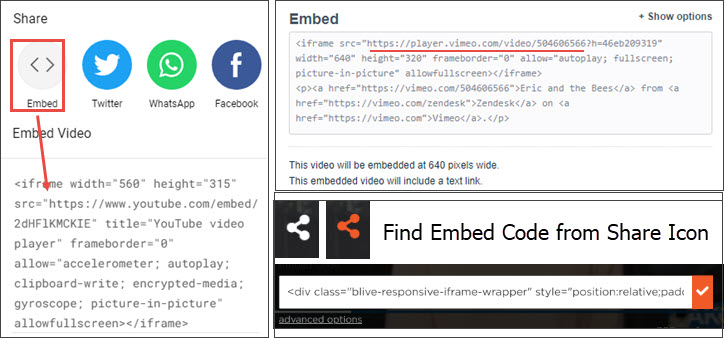
Step 1. Copy the embed code of the video.
You can click the Share button (if available) on the video player embedded on a website page, hit the "Embed" tab, and copy and paste the code into a text editor such as Word from Microsoft Office, or Notepad.
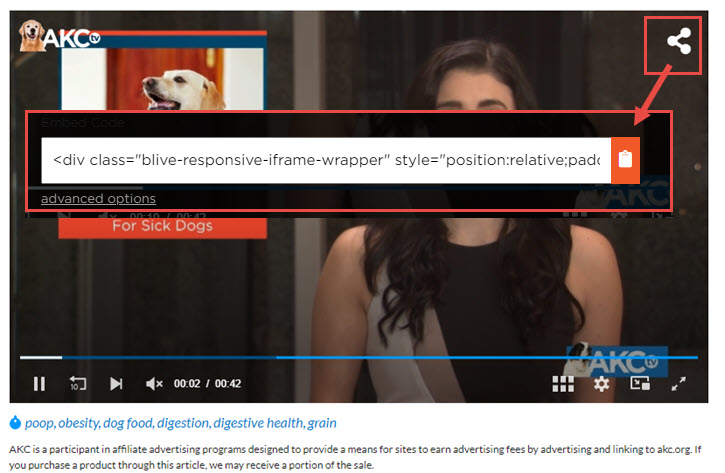
Alternatively, you can also use the Inspect Tool of the browser (the developer tool) to see the source code, and press Ctrl+F to find something within the <iframe></iframe> tag.
Step 2. Find the string src="https://www.xxx.xxx". The URL inside the quotation mark is the embedded video.
Example:
Here is the embed code of a video embedded on a dog food blog:

You need to find the link within the scr="" string.
Note: Once you find the embedded video link, you still cannot directly download it. You need to use a dedicated Video Downloader software to analyze the link to save the video.
The recommended tool is VideoProc Converter AI introduced in method 1 above.
Step 3. Copy and paste the URL into VideoProc Converter AI to extract the embedded video from the website.
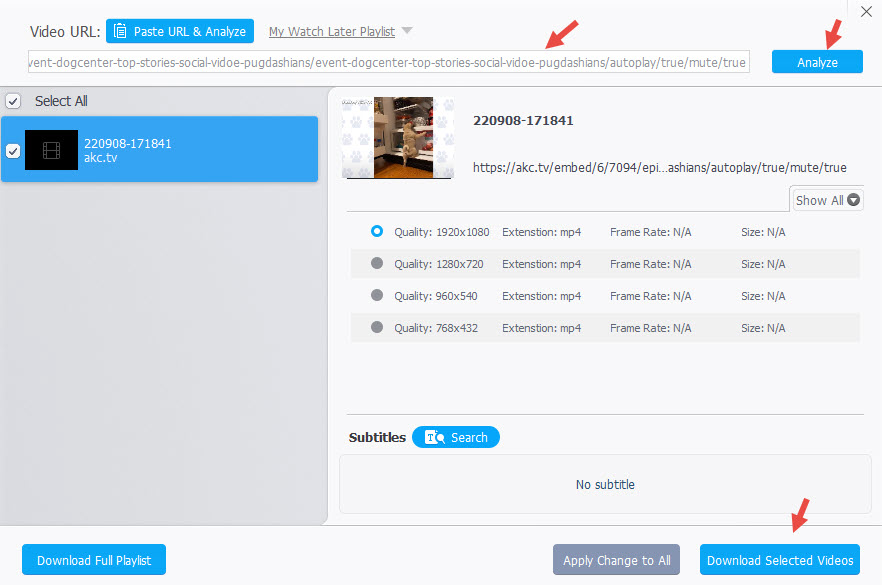
Free download VideoProc Converter AI to extract embedded videos from websites now:
FAQs
How do I download an embedded video from a news website?
There are generally 4 ways to download videos embedded on a news website: 1. Using a dedicated video downloader to analyze its link; 2. Using the developer tool to find the network activity and thus identifying its video URL; 3. Use browser extensions; 4. Capture the video. Sometimes, analyzing the webpage link won't work, so you need to find out the true link pointing to the video, using the methods listed on this page.
Can I Use VideoProc Converter AI to Download Iframe Videos?
Yes, you can. An iframe is simply a method to embed a video onto a webpage, using the tag <iframe></iframe>. With video links inside the tag, or hidden from users.
Using VideoProc Converter AI, the process is the same as downloading any other embedded videos. Just copy the URL of the page where the video is playing, let VideoProc detects the video within the iframe, and save the video.









